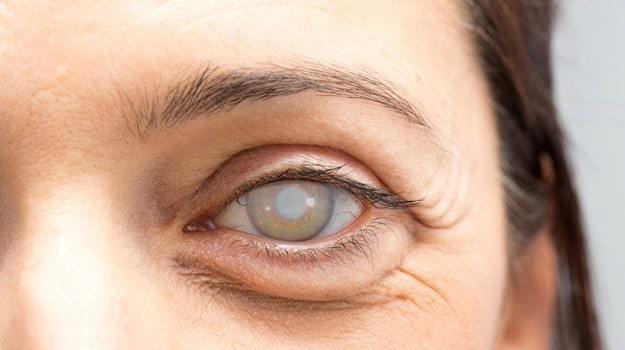
Please wait...

Please wait...
Cataract is an opacity of the natural (or crystalline) lens of the eye, which is located behind the iris and pupil. Cataracts are the most common cause of vision loss in people over 40 and it is the leading cause of blindness in the world
The types of cataracts include:
In the beginning, the falls are very small, and almost do not alter vision. You will notice that your vision becomes a little blurry, as if you were looking through a piece of glass or appreciating an impressionist painting.
A foggy and cloudy vision can mean the presence of cataracts.
Because of the cataract, sunlight or a lamp may appear excessively bright or dazzling. You will also notice that when driving at night, the lights of the front cars dazzle you more than before. The colors, however, will appear less bright.
The type of symptoms you suffer and the times of their appearance depend exclusively on the type of cataract you have. At the beginning of a nuclear cataract, you may notice a temporary improvement in your near vision, known as «secondary vision.»
If you think you have cataracts, consult your vision professional to examine and confirm your condition.
The lenses inside the eye work in a very similar way to those of a camera, focusing the light on the retina to obtain a clear vision. They also adjust the focus of the eye, allowing us to clearly see both distant and nearby objects.
The lens consists mostly of water and proteins. The proteins are very precisely arranged and keep the lens free of irregularities, allowing the passage of light through.
With age, some of the proteins may begin to form clusters so that a small area of the lens is clouded. This is known as a cataract, and with the passage of time, more areas of the lens can grow and cloud, making vision more and more difficult.
It is not known with certainty why the lens of the eye changes with age, forming cataracts. However, researchers around the world have managed to identify factors that may cause cataracts or that have some association with their development. In addition to advanced age, the risk factors for the appearance of cataracts are:
One theory about the formation of cataracts that has gained adherents is that many are caused by oxidative changes in the lens. This theory is supported by studies in nutrition that show that a diet with fruits and vegetables rich in antioxidants can help prevent certain types of cataracts (see below).
Although the issue about the possibility of preventing cataracts is very controversial, numerous studies suggest that certain nutrients or nutritional supplements may reduce the risk of developing cataracts.
A large-scale study of 10-year-old female health professionals found that diets high in vitamin E, carotenoids, lutein and zeaxanthin in both foods and supplements are associated with a significant reduction in risk of developing cataracts.
Sunflower seeds, almonds and spinach are a good source of vitamin E. For the consumption of lutein and zeaxanthin, spinach, cabbage and leafy vegetables are recommended.
Other studies have shown that antioxidant vitamins such as vitamin C and foods containing omega 3 fatty acids can cause a reduction in the risk of cataracts.
Visit our Nutrition and Eyes section to read more about vitamins for the eye and how a healthy diet and proper nutrition can help prevent cataracts.
Another step that can be taken to reduce the risk of cataracts is to use protective sunglasses, which block 100 percent of the sun’s UV rays when the person is outdoors.
When symptoms begin to appear, you can improve your vision for a while using new glasses, powerful bifocals, appropriate lighting or other visual aids.
Consider surgery only when your cataract has progressed enough to have seriously altered your vision and affects your daily life. Many people consider poor vision as an inevitable part of aging, and yet cataract surgery is a simple procedure, virtually painless, capable of returning your vision.
Cataract surgery is very successful in vision recovery. In fact, it is the most frequently performed surgery in the United States. More than 3 million Americans are operated annually, according to PBA.
Nine out of ten people who operate on cataracts recover their vision with a very good level, between 20/20 and 20/40. During the procedure, the surgeon will remove the cloudy lens and in most cases it will replace it with a plastic intraocular lens (IOL).
New IOLs are constantly being developed to make surgery less and less complicated for surgeons, and the lens is increasingly useful for patients. IOLs «that correct presbyopia» have the potential to allow sight recovery for all distances, not just one. Another new type of IOL blocks both ultraviolet and blue light, which, according to research, can damage the retina.
You can read more on this site about what to expect if you have cataract surgery and how to cope with some complications that rarely occur during it.
Also, men should keep in mind that certain prostate medications can cause intra-operative flexible iris syndrome (IFIS) during surgery.
In most cases, unless you prefer intraocular lenses (IOLs) to correct presbyopia, you will need reading glasses after cataract surgery. You may also need progressive glasses to correct minor residual refractive errors, as well as presbyopia.
To achieve the best possible vision and comfort with prescription glasses after cataract surgery, ask your optician to explain the benefits of anti-glare coating and photochromic glasses.
